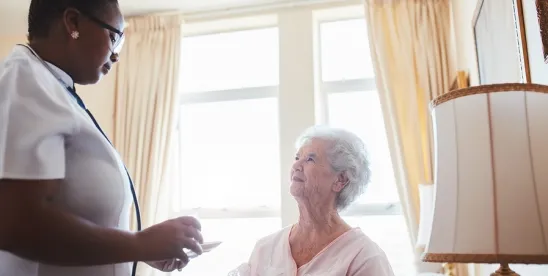New York state has been encouraging consolidation in the licensed home care services agency (LHCSA) space. The 2018-19 State Budget imposed a two-year moratorium on new LHCSAs, limited the number of LHCSAs with which managed long-term care plans can contract, and gave the New York Department of Health (DOH) authority to develop a public need methodology for evaluating LHCSA applicants. The purpose of the need methodology is to ensure adequate access to LHCSAs while avoiding proliferation of unnecessary LHCSAs.
Over the past several months, DOH has been developing the public need standards, which once finalized, will take effect April 1, 2020. At that time, the New York Public Health and Health Planning Council (PHHPC) will be required to evaluate the public need for services to be provided by a LHCSA applicant, as well as the applicant’s financial resources.
In July 2018, DOH issued a Request for Information (RFI) to gather input for the new public need methodology. The RFI sought stakeholder input on planning area designations, methodology factors, methodology exceptions, and any additional considerations. Comments were due Oct. 12, 2018.
On March 28, 2019, DOH presented the RFI responses to PHHPC’s Committee on Health Planning. DOH indicated it will consider the responses in its development of the need methodology, which will be adopted through the formal rulemaking process. Below is a summary of the DOH presentation and the discussion points raised.
LHCSAs Subject to the Need Methodology
The Public Health Law contemplates that any initial licensure, purchase, merger, or change of ownership or control of a LHCSA must satisfy the public need requirement. However, to be consistent with the rules for certified home health care agencies, DOH is considering recommending a statutory change to exempt change of ownership applicants from the certificate of need (CON) process. The majority of RFI respondents supported this modification. In addition, DOH is considering exempting from the CON process LHCSAs that only service assisted living programs (ALPs).
DOH may also recommend statutory and regulatory changes to include construction provisions for LHCSAs, and contemplates requiring any addition or deletion of services, change in geographic service area, change to physical structures or equipment, or change in the method of providing services to be subject to the need methodology.
Need Methodology Considerations
DOH is recommending the need methodology presume there is no need for additional LHCSAs when the projected capacity in a county is 90% or more of the projected need in that county. The following factors may be considered to rebut the presumption:
-
Workforce availability and access;
-
Transportation and long-term care infrastructure;
-
Telehealth and other technologies;
-
Community characteristics (cultural, rural, suburban, urban, etc.);
-
Value-based payment contracting experience; and
-
High-risk patients or those with specialty service needs.
To determine projected need, DOH is considering looking at normative use rates for a county based on population estimates for a base year and U.S. Census Bureau data for a target year. The normative use rates would be based on either unduplicated patient encounters or the number of cases and visits/hour in a county as reported on the LHCSA Statistical Report, divided by the county population for the base year. The projected unmet need would be determined by multiplying the normative use rate by the estimated county level population for the target year. Alternatively, estimates based on demographics for disease and disability of residents with limitations in completing activities of daily living would be used to determine the unmet need. DOH notes, however, that although this approach would best reflect the individuals in a county in need of care, historically it has proven challenging to gather the relevant information.
To determine projected capacity, DOH suggests looking at the normative use rates for the two most recent calendar years and the rate of change for each existing LHCSA. The unmet need would be determined by comparing the projected need to the projected capacity for each county.
In accordance with the RFI responses, DOH proposes review of the need methodology on a regular and consistent basis (e.g., every three to five years).
Financial Feasibility Considerations
DOH recommends that the PHHPC review the financial resources available to a LHCSA applicant, as well as the LHCSA’s projected revenues and expenses based on a reasonableness standard of review. In other words, the applicant must have reasonable sources for start-up capital (e.g., a minimum of two months’ expenses) and, over time, projected operating revenue must be equal to or greater than projected expenses.
Planning Area Considerations
Geographic boundaries for public need estimates are typically determined at the county level. However, the RFI respondents made other suggestions for DOH’s consideration, including: geographic regions within a county; different planning areas upstate and downstate; population concentration; and travel times and transportation infrastructure. DOH has proposed the following options in response: (1) designate each county as a separate planning area; (2) allow for alternate planning upon request and approval by the PHHPC; and (3) require LHCSAs to serve an entire planning area unless special circumstances exist to justify otherwise (e.g., geographic or travel time barriers or workforce challenges).
Other Considerations
In addition to the factors discussed above, the Committee on Health Planning raised the following questions, suggestions, and comments for DOH’s consideration: (1) whether existing LHCSAs need to increase their workforce to meet the demand in a geographic area rather than increasing the number of LHCSAs to serve the area; (2) DOH should review need in line with DOH’s other public policy objectives, such as ensuring sufficient scale for LHCSAs to enter into value-based purchasing arrangements, supporting health information technology, statutory wage mandates, and encouraging women and minority owned businesses; and (3) an exemption of LHCSAs that are part of a larger health care system (i.e., owned by hospitals or other large health care enterprises). All the home care trade associations responded to the RFI and recommended the formation of a workgroup to develop the need methodology and any implementing regulations.
The Committee on Health Planning may report on its March 28 meeting at the PHHPC Full Council Meeting, to be held in Albany on April 11, 2019. Thereafter, DOH will review public comments and begin drafting regulations, which will then be subject to further public input and comment.
For more information on the LHCSA CON methodology, click here.



 />i
/>i

